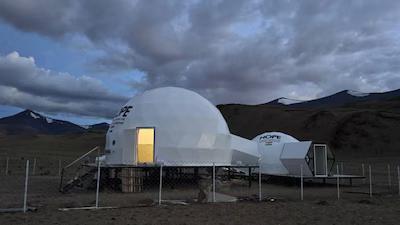
ISRO Sets Up Station in Ladakh to Simulate Life on Moon & Mars
In a significant step towards exploring the vast expanse of space, the Indian Space Research Organisation (ISRO) has set up a unique station in Ladakh’s Tso Kar Valley to simulate life on the Moon and Mars. The Himalayan Outpost for Planetary Exploration (HOPE) is a 10-day simulation mission that will test life-support systems for future lunar and Martian missions. This ambitious project aims to prepare Indian astronauts for the harsh conditions they will face while venturing out into space.
The Tso Kar Valley was chosen as the ideal location for the simulation mission due to its extreme environment, which is eerily similar to that of Mars. The valley is characterized by high UV radiation, low atmospheric pressure, extreme cold, and saline permafrost – making it an ideal replica of the Martian terrain. The extreme conditions will allow ISRO scientists to test the durability and effectiveness of the life-support systems designed for future space missions.
The HOPE station will be inhabited by two crew members from August 1-10, who will undertake various tests and experiments to simulate life on the Moon and Mars. The crew will be responsible for monitoring the station’s systems, conducting scientific experiments, and performing tasks that will help scientists understand the challenges of living in space.
The simulation mission will focus on testing the life-support systems, including air, water, and food supplies, as well as the psychological impact of living in isolation for extended periods. The crew will also conduct experiments to study the effects of extreme temperatures, radiation, and low air pressure on the human body.
ISRO scientists believe that the HOPE station will provide valuable insights into the challenges of space exploration and help them to develop innovative solutions to overcome them. The data collected from the simulation mission will be used to refine the designs of future space missions, ensuring the safety and comfort of astronauts during their journeys to the Moon and Mars.
The HOPE station is a significant milestone in India’s space exploration program, which has been gaining momentum in recent years. ISRO has made significant strides in recent years, including the successful launch of the Chandrayaan-1 mission, which helped India become the fourth country in the world to soft-land on the Moon.
The simulation mission is also a testament to India’s growing capabilities in space technology and its commitment to exploring the vast expanse of space. The country has set ambitious targets for its space program, including plans to send humans to space by 2022 and to establish a permanent human settlement on the Moon by the 2030s.
The HOPE station is a crucial step towards achieving these goals, as it will provide valuable insights into the challenges of space exploration and help scientists to develop innovative solutions to overcome them. The simulation mission is a testament to India’s growing capabilities in space technology and its commitment to exploring the vast expanse of space.
Source:






